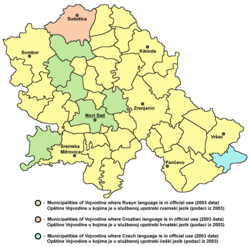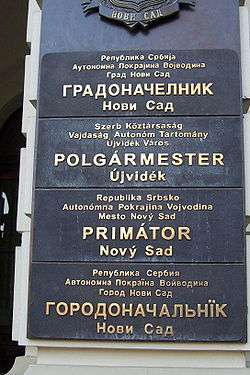Pannonian Rusyn language
| Pannonian Rusyn | |
|---|---|
|
Руски язик Ruski jazik | |
| Native to |
Serbia Croatia |
| Ethnicity | Pannonian Rusyns |
Native speakers | 20,000 |
|
Indo-European
| |
| Cyrillic (Pannonian Rusyn alphabet) | |
| Official status | |
Official language in |
|
| Regulated by | Statute of Vojvodina |
| Language codes | |
| ISO 639-3 | – |
rue-par | |
| Glottolog | None |

Pannonian Rusyn, or simply Rusyn (руски язик (ruski jazik), руска бешеда (ruska bešeda), русински язик (rusinski jazik); or Ruthenian), is a language spoken by the Pannonian Rusyns, in north-western Serbia (Bačka region) and eastern Croatia. Before the re-establishment of independent Serbian and Croatian states, in the 1990s, the area was part of the former federation of Yugoslavia. Pannonian Rusyn is one of the official languages of the Serbian Autonomous Province of Vojvodina.[1] The Pannonian Rusyns themselves call their language Bačvan'ska ruska bešeda (бачваньска руска бешеда), or Bačvan'ski ruski yazik (бачваньски руски язик), both meaning "the Rusyn language of Bačka". Pannonian Rusyn has also sometimes been known as Yugoslavo-Ruthenian, Vojvodina-Ruthenian or Bačka-Ruthenian.
There is controversy regarding whether Pannonian Rusyn is a distinct microlanguage, or a dialect of the Rusyn (or Carpathian Rusyn) language, which is spoken in a a trans-border region of Ukraine, Slovakia, Poland, Hungary, the Czech Republic and Romania.
Like most other Rusyns – and unlike Serbs or Croats – most Pannonian Rusyns were traditionally members of the Ruthenian Catholic Church, a branch of Greek Catholicism. Religious differences have also, therefore, significantly influenced the distinctiveness of the Pannonian Rusyn language.
While up to date figures are not available, the Yugoslavian federal census of 1981 counted 23,286 Rusyns.
Classification
Both Pannonian Rusyn and Carpathian Rusyn are East Slavic languages. Pannonian Rusyn differs from Carpathian Rusyn in that the former has been influenced by the surrounding South Slavic languages (especially Serbian) whilst the latter has been influenced by the surrounding West Slavic languages (especially Polish and Slovak. Both forms of Rusyn are closely related to Russian Church Slavonic, Old Ruthenian and modern Russian.
Among the West Slavic languages, Rusyn has been especially influenced by the Eastern Slovak dialects. This influence occurred before the Rusyns emigrated to Pannonia from the north Carpathian area, around the middle of the 18th century.
Education
As early as the 1970s, the Pannonian Rusyns were granted certain minority rights by the former Yugoslavia, which was a multinational state. Consequently, there is a Rusyn language high school in Ruski Krstur (Руски Керестур, Serbian: Руски Крстур / Ruski Krstur), the cultural centre of the Pannonian Rusyns. At least 250 Rusyn language books have been printed so far for the high school and elementary schools in the region.)
There is a professorial chair in Rusyn Studies at Novi Sad University.[2] [3]
Media
There are regular television and radio programmes in Pannonian Rusyn, including the multilingual radio station Radio Novi Sad, which serves all of Vojvodina. The breakdown of minutes of Novi Sad original broadcasting by language in 2001 was: 23.5% Serbian, 23.5% Hungarian, 5.7% Slovak, 5.7% Romanian, 3.8% Rusyn, 2.2% Romani, and 0.2% Ukrainian.
Writing system
Pannonian Rusyn was codified by Mikola Kočiš in Правопис руского язика (Pravopis ruskoho yazika; "Orthography of Rusyn", 1971) and Ґраматика руского язика (Gramatika ruskoho yazika; "Grammar of Rusyn", 1974) and is written in a Cyrillic script.
The Pannonian Rusyn alphabet А а Б б В в Г г Ґ ґ Д д Е е Є є Ж ж З з И и Ї ї Й й К к Л л М м Н н О о П п Р р С с Т т У у Ф ф Х х Ц ц Ч ч Ш ш Щ щ Ю ю Я я Ь ь
The Pannonian Rusyn alphabet has 32 letters. It includes all the letters of the Ukrainian alphabet except І/і. Like the Carpathian Rusyn alphabets, and like the Ukrainian alphabet until 1990, the Pannonian Rusyn alphabet places ь after я, while the vast majority of Cyrillic alphabets place ь before э (if present), ю, and я.
Comparison with the Carpathian Rusyn alphabets
The Prešov Rusyn alphabet of Slovakia has 36 letters. It includes all the letters of the Pannonian Rusyn alphabet plus ё, і, ы, and ъ.
The Lemko Rusyn alphabet of Poland has 34 letters. It includes all the letters of the Pannonian Rusyn alphabet with the exception of ї, plus і, ы, and ъ.
In the Ukrainian alphabet, и precedes і and ї, and the Pannonian Rusyn alphabet (which doesn't have і) follows this precedent by placing и before ї. In the Prešov Rusyn alphabet, however, і and ї come before и, and likewise, і comes before и in the Lemko Rusyn alphabet (which doesn't have ї).
